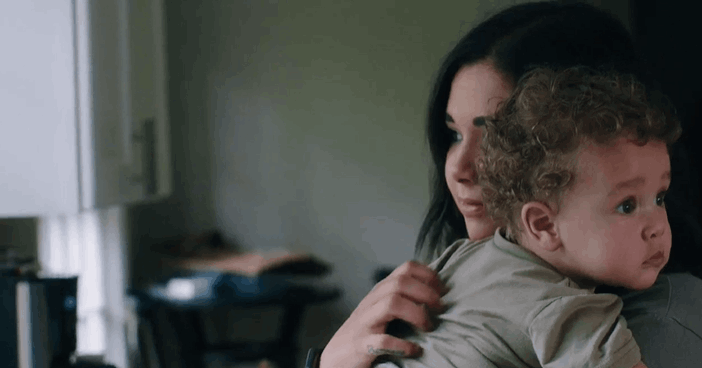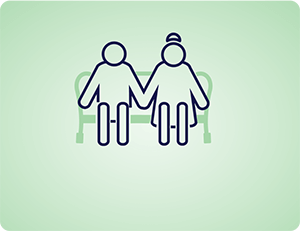Anyone can be infected by respiratory syncytial virus (RSV)1
Learn which patients are at risk of severe RSV disease and uncover the importance of protecting against RSV.1
why
Uncover RSV
A VIRAL RESPIRATORY THREAT
RSV CAN BE EASILY MISTAKEN FOR INFLUENZA1
LIKE INFLUENZA, RSV IS AN RNA VIRUS THAT IS2:

HIGHLY CONTAGIOUS3-5
HIGHLY CONTAGIOUS3-5
- RSV is spread through close contact with infected individuals or contact with infected surfaces3
- RSV can be spread through infected surfaces for extended periods of time, with examples including skin (30 minutes), fabric (2 hours), gloves (5 hours) and furniture (7 hours)5

SEASONAL6-8
SEASONAL6-8
- RSV incidence tends to overlap with influenza season, typically occurring between late fall and early spring in the US6,7
- RSV can be unpredictable: peak seasons can vary up to a month based on location and time.8

COMMON CAUSE OF ACUTE RESPIRATORY INFECTIONS(ARI)1,3,5
COMMON CAUSE OF ACUTE RESPIRATORY INFECTIONS(ARI)1,3,5
- Although most patients experience mild symptoms that can be resolved on their own, RSV-associated ARI can cause severe respiratory complications in certain cases.1,3,5
- When spread to the lower respiratory tract, RSV-associated ARI could lead to bronchiolitis and pneumonia1,3,5
Most people get RSV before 2 years old, and are at risk of another infection for the rest of their lives.9,10
For some people, RSV can be just as serious as influenza.11-15
In infants12,13*

In infants12,13*
RSV has exhibited higher death rates than influenza in infants12
In a study from Washington State, the incidence of RSV in infants seen at outpatient clinics was 7x higher than that of influenza13
In some adults with certain risk factors14

In some adults with certain risk factors14
Among adults who are immunocompromised or have an underlying condition like COPD or congestive heart failure, RSV has been associated with medical resource utilization similar to that of influenza14
In adults 60 years and older15†

In adults 60 years and older15†
Older adults hospitalized for RSV had longer hospital stays (≥7 days) and worse 1-year survival rates compared with patients with influenza15
†Based on a study of RSV patients aged 60 years and above15
Hear real stories of RSV's impact

who
Uncover RSV
People of all ages, both healthy and with certain chronic conditions, are at risk of RSV.16

Anyone could get infected by RSV17
Many may display no symptoms or mild symptoms only, but could still spread RSV to others.18
Those with flu symptoms can avoid spreading RSV through the following ways20:
However, some populations remain at risk of severe disease outcomes: 21,22
Preterm babies aged 6 months and below22

Children with chronic conditions, aged 2 years and below22

Older adults aged 65 and above21

Those with an immunodeficiency21,22

Patients with certain chronic illnesses
Such as chronic heart or lung disease21,22

what
UNCOVER RSV
An underestimated cause of respiratory tract infection1,5
RSV TYPICALLY BEGINS WITH COMMON SYMPTOMS OF UPPER RESPIRATORY TRACT INFECTION (URTI) BUT CAN PROGRESS TO LOWER RESPIRATORY TRACT INFECTION (LRTI)3,5
Click the circles to find out more
Graphics for demonstration purposes only
SYMPTOMS OF RSV CAN RANGE FROM MILD COLD-LIKE SYMPTOMS TO SEVERE RESPIRATORY DISTRESS.6,14,24,25
INFANTS & YOUNG CHILDREN6,25,26

IN INFANTS, CLINICAL PRESENTATION MAY INCLUDE6,25,26:
- Bronchiolitis6
- Pneumonia25
- Croup25
- Apnea26
- Upper respiratory tract infection25
ADULTS WITH CERTAIN CHRONIC CONDITIONS27,28

IN SOME ADULTS WITH CERTAIN CHRONIC CONDITIONS, RSV MAY PROGRESS TO SEVERE COMPLICATIONS THAT RESULT IN27,28:
- Respiratory failure28
- Prolonged hospitalization28
- High mortality28
*While the study design was for adults 18 years and older, the mean age at time of diagnosis was 75.1 years in the RSV group and 74.7 years in the influenza group.
OLDER ADULTS3,5

IN OLDER ADULTS, CLINICAL PRESENTATION MAY INCLUDE3,5,21:
- Upper respiratory tract infection3,5
- Exacerbation of asthma, chronic obstructive pulmonary disease, and chronic heart failure14
- Pneumonia21
how
Uncover RSV
RSV IS A VIRUS THAT EXPOSES SOME TO POTENTIALLY SERIOUS OUTCOMES1,3,5,14
In the United States, RSV in infants has caused3:
Approximately 40%-90%
Of bronchiolitis-related hospitalizations3
Up to 50%
Of pneumonia-related hospitalizations3
The seasonal incidence of medically attended RSV in infants (aged between 6-11 months) was two times of older children (aged between 24-59 months).29§
(Note: Hong Kong has no similar epidemiological study)
In medically-attended paediatric patients (aged above 1 and below 18), RSV infections were more common in younger children13||:
184.4 persons
/1000 persons
Aged 1
110.9 persons
/1000 persons
Aged 2-4
31.4 persons
/1000 persons
Aged 5-9
10.3 persons
/1000 persons
Aged 10-17
What is the impact of RSV on infants in Hong Kong?
On average, 314 infants per year per 10000 infants (aged 0-4 years)
Were hospitalized due to RSV30
Approximately 37% of infants (aged 0-4 years) hospitalised due to respiratory disease
Were infected with RSV30
IN A STUDY OF ADULT PATIENTS WITH CORE RISK FACTORS FOR SEVERE RSV OR INFLUENZA INFECTION14:
A GREATER PROPORTION OF PATIENTS WITH RSV AND CORE RISK FACTORS REQUIRED HOSPITAL STAYS >3 DAYS COMPARED TO PATIENTS WITH INFLUENZA AND CORE RISK FACTORS14
RSV PATIENTS EXPERIENCED MORE COMPLICATIONS DURING HOSPITALIZATION, INCLUDING LOWER RESPIRATORY COMPLICATIONS, CARDIOVASCULAR COMPLICATIONS, AND BACTERIAL SUPERINFECTIONS, COMPARED TO PATIENTS WITH INFLUENZA14
In a study of adult RSV patients (with and without preexisting conditions), older adults had worse prognoses compared to adults aged between 18-49.32:
3 times more of hospitalization
When comparing older patients aged ≥65 with adult patients aged 18-49.31
Longer duration of hospitalization
When comparing older patients aged ≥65 and adult patients aged 18-49.32
Up to two times of A&E and out-patient clinic visits
When comparing older patients aged ≥65 and adult patients aged 18-49.32







